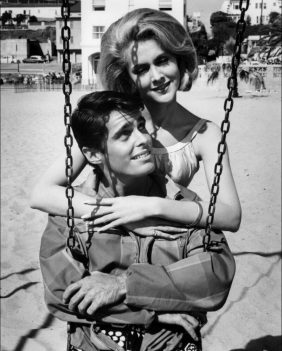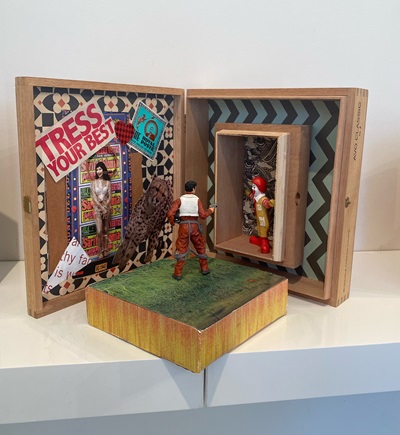At the Olympia Club, a gallery and barbershop in Santa Monica, the transition from actor to artist is on display in “A Life In Collage,” an engaging exhibition that needs to be seen.
By John Lavitt
Santa Monica, CA (The Hollywood Times) 12/6/23 – When the final curtain on a successful acting career comes down, is the voice silenced? At their very core, actors are expressive artists who need to continue to be heard beyond the stage. In the intriguing case of Rick Rogers, the artist went from being on the stage to creating the stage.
Although we want to delve deeply into his new exhibition – “A Life in Collage” at the Olympia Club in Santa Monica, a little of the past should be excavated first. However, before this excavation takes place for the casual reader, let us remind you that the exhibition opened on December 2, 2023, and will close on January 2, 2024. After a well-populated opening night with fine wine, big smiles, gourmet food, and laughter flowing, over a dozen pieces from the show have already sold. Thus, if you want to own a Rick Rogers original, the time to strike is now.
When Rick Rogers was an actor in Hollywood, he was known as Steven Rogers. In 1962, when Rick Rogers got his big break as combat medic “Doc Walton” on the World War II television drama Combat, he changed his name. Although he was born Richard Alan Rogers, he went by Rick in Hollywood. The stage name “Steven” was adopted so Rick would not be confused with series lead Rick Jason. What is funny is that Steven Rogers is also the actual name of Captain America, the superhero who, along with Iron Man, is the heart of The Avengers, and the name has become popularized in the modern age of Marvel movie dominance.

After a season on Combat (1962), where Rogers fondly remembers working with legendary director Robert Altman, who helmed ten of the episodes, the actor moved on. After meeting Roger Corman, he made a series of fun films aimed at teenage audiences, like The Girls on the Beach (1965), Wild Wild Winter (1966) and Angels From Hell (1968). Indeed, Hollywood was taking advantage of the young man’s natural charm and rugged good looks. By the way, we hope Rick’s wife, the lovely Carmen Rogers, will forgive us for the above photo.
After his Hollywood career, Rogers found his voice in many creative ventures, ranging from costume design to theatre restoration. However, nothing gave the artist a greater sense of meaning than his collage work, two-dimensional on canvases and three-dimensional as boxed dioramas. Both kinds of work are well-represented in the new exhibition at the Olympia Club. Indeed, Rogers’s three-dimensional work is a natural extension of his two-dimensional work since his two-dimensional ideas feel like they leap off the canvas.
A perfect example is “NY, NY” (1990), a two-dimensional piece by Rick Rogers that, unfortunately, has already sold. A collage of Truman Capote, The Carlyle Hotel, and Barney’s New York, along with a beautiful pinup lady, reflects the excitement of the city back in the day. Rogers uses a fine sense of placement and layering to give insight into the hustle and bustle of the big city. Indeed, the piece generates nostalgia as the viewer wishes to return to times past.
Shifting from the two-dimensional work to the diorama, “Double Jeopardy” (2023) shows how the art of Rick Rogers has evolved over the years. The diorama focuses on a pilot who, after parachuting into a surrealistic jungle nightclub, has a gun trained on Ronald McDonald. The pilot ignores the cheetah stalking him on the side and the beautiful showgirl wrapped in plastic. Instead, he is intent on ignoring the double jeopardy. The focus is stopping the American propagator of fast-food nightmares. Indeed, the inventive piece plays with the nature of societal commentary by making the viewer find meaning in dissonance.

Overall, the work of Rick Rogers needs to be seen live to be truly appreciated. In this exhibition, seeing all the work in a single setting is wonderful. It allows for the creative soul of a lifelong artist to be revealed as the viewer experiences “A Life in Collage.”
Photos Courtesy of Rick Rogers